
Carpentry Technology
Get started today
About Carpentry Technology
The Carpentry Technology program provides carpentry students with a positive and professional experience. By using the most up-to-date equipment and the newest technology, program faculty strive to always run parallel with the present-day building industry. Students receive two years of excellent training that sufficiently prepares them for the residential and light commercial construction workforce.
What you’ll learn
- Write clear, concise, legible, and accurate technical reports and be skilled in oral communication related to the construction industry.
- Demonstrate the basic manipulative skills of the trade that are necessary in laying out work, planning, erecting, and framing.
- Interpret and prepare plans, drawings, codes and specifications, lines, symbols, and abbreviations on working drawings or blueprints.
- Analyze specifications and contract drawings as well as make accurate quantity take-offs and labor estimations to develop an estimated construction cost for a building project.
- Demonstrate the ability to lay out and erect a platform or western frame structure.
- Demonstrate basic knowledge and skill in masonry and in the concrete construction trade.
- Describe various types of materials and methods available to the construction trade.
- Describe business organization, financing, labor relations, selling, pricing, customer service, management, and other business principles.
- Describe the complexity of the building construction industry, the interrelationships of the various trades, and methods of communication and coordination among all trades and professions within the industry.
- Encourage the practice of staying current with any new technology or codes related to the building industry.
Sample Job Titles
Assembler, Bridge Carpenter, Bridge Repair Crew Person, Cabinet Maker, Carpenter, Concrete Carpenter, Construction Worker, Form Carpenter, Framer, Rough Carpenter
Soar Agreement
This program enables students to apply certain credits earned in high school to the credits needed for a degree or certificate through Thaddeus Stevens College. The Carpentry Technology degree qualifies for this program – see our SOAR program page for details!
Quick facts
Location
Leonard Building, Main Campus
Type of program
Associate Degree
Job/Salary Outlook
See industry data
Length of program
2 years, 73 credits
Cost of program
$4,500/semester tuition
$3,000 – $3,500/semester housing
$1,850 – $2,335/semester meal plan
Tool List (PDF)

The outcomes speak for themselves
Students receive two years of excellent training that sufficiently prepares them for the residential and light commercial construction workforce.
95.7%
employment
$45K
med. salary
People of TSCT
Success stories
Program details
Courses
MODEL SCHEDULE FOR CARPENTRY TECHNOLOGY
Semester 1
- CARP 106 Hand Tools and Power Tools (3 credits)
- CARP 111 Building Materials (3 credits)
- CARP 116 Site Work and Foundations I (3 credits)
- CARP 182 Construction Drawings & Blueprint Reading (3 credits)
- ENG 106 English Composition I (3 credits)
- MATH 126 Technical Math I (or Higher Level Math) (3 credits)
Semester 2
- CARP 157 Floor, Wall, and Ceiling Framing (3 credits)
- CARP 161 Stair Construction (2 credits)
- CARP 166 Roof Framing and Materials (3 credits)
- CARP 178 Exterior and Interior Finish (4 credits)
- MATH 132 Geometry (or Higher Level Math) (3 credits)
- CIS 111 Intro to Computer Application (3 credits)
Semester 3
- CARP 208 Floor Construction (3 credits)
- CARP 209 Wall Construction (3 credits)
- CARP 218 Roof Construction (3 credits)
- CARP 219 Thermal Insulation (1 credit)
- CARP 222 Exterior Finish and Trim (2 credits)
- English Elective (recommend Eng 216 or Eng 221) (3 credits)
- BUSN 106 Small Business Management (3 credits)
Semester 4
- CARP 227 Drywall Installation and Finish (2 credits)
- CARP 257 Stair Trim (2 credits)
- CARP 267 Interior Finish and Trim (3 credits)
- CARP 272 Site Work and Foundations II (2 credits)
- CARP 276 Residential Remodeling (3 credits)
- Science Elective (3 credits)
- Humanities Elective (3 credits)
Additional General Education Requirements
- HEAL Elective HEAL 106 or HEAL 111 (1 credit)
- Elective General Studies Elective (3 credits)
Total Credits 73
Faculty
Occupational Advisory Committee
The Occupational Advisory Committee (OAC) serves as a vital link between the Program of study and industry, ensuring that the program remains aligned with current workforce needs, technological advancements, and best practices in the field. Composed of employers, educators, and other community members, the committee provides guidance, feedback, and recommendations to enhance the curriculum, instructional methods, and student learning experiences.
Purpose and Responsibilities:
- Curriculum & Industry Alignment
- Workforce Readiness
- Student & Faculty Support
- Internship & Employment Connections
- Accreditation & Program Evaluation
- Facilities & Equipment Recommendations
By fostering a strong relationship between academia and industry, the OAC helps ensure that Thaddeus Stevens College programs maintain the highest standards in CTE (career and technical education).
- Heidi Brady, Wohlsen Constructions
- Todd Goshert, Heck Construction Company, Inc.
- Lorie Grucelski, TK Building & Design
- Jacob Komorowski, Komorowski Construction
- Bill Lastinger, Benchmark Construction Company
- Matt Oswald, Benchmark Construction Company Inc
- Sean Riccardelli, CCS Building Group
- Stephanie Titus, Keystruct Construction
Essential Skills Learned
Tasks
- Follow established safety rules and regulations and maintain a safe and clean environment.
- Study specifications in blueprints, sketches, or building plans to prepare project layout and determine dimensions and materials required.
- Measure and mark cutting lines on materials, using a ruler, pencil, chalk, and marking gauge.
- Shape or cut materials to specified measurements, using hand tools, machines, or power saws.
- Install structures or fixtures, such as windows, frames, floorings, trim, or hardware, using carpenters’ hand or power tools.
- Verify trueness of structure, using plumb bob and level.
- Select and order lumber or other required materials.
- Arrange for subcontractors to deal with special areas, such as heating or electrical wiring work.
- Maintain records, document actions, and present written progress reports.
- Build or repair cabinets, doors, frameworks, floors, or other wooden fixtures used in buildings, using woodworking machines, carpenter’s hand tools, or power tools.
- Erect scaffolding or ladders for assembling structures above ground level.
Tools used in this occupation
- Air Compressors
- Alignment Jig — Baluster jigs; Level jigs
- Bandsaw wheel — Bandsaws
- Belt sander — Belt sanders
- Bevels — Sliding t-bevels
- Biscuit Jointers — Biscuit joiners; Joiners
Technology used in this occupation
- Accounting software — Intuit QuickBooks; Intuit Quicken; Job costing software
- Office suite software — Microsoft Office
- Project management software — Bosch Punch List; Estimating software; Turtle Creek Software Goldenseal; VirtualBoss
- Spreadsheet software — Microsoft Excel
- Word processing software — Microsoft Word; Wilhelm Publishing Threshold
Knowledge
- Building and Construction — Knowledge of materials, methods, and the tools involved in the construction or repair of houses, buildings, or other structures such as highways and roads.
- Mathematics — Knowledge of arithmetic, algebra, geometry, calculus, statistics, and their applications.
- Design — Knowledge of design techniques, tools, and principles involved in the production of precision technical plans, blueprints, drawings, and models.
- Mechanical — Knowledge of machines and tools, including their designs, uses, repair, and maintenance.
- English Language — Knowledge of the structure and content of the English language including the meaning and spelling of words, rules of composition, and grammar.
- Administration and Management — Knowledge of business and management principles involved in strategic planning, resource allocation, human resources modeling, leadership technique, production methods, and coordination of people and resources.
- Education and Training — Knowledge of principles and methods for curriculum and training design, teaching and instruction for individuals and groups, and the measurement of training effects.
- Public Safety and Security — Knowledge of relevant equipment, policies, procedures, and strategies to promote effective local, state, or national security operations for the protection of people, data, property, and institutions.
Skills
- Active Listening — Giving full attention to what other people are saying, taking time to understand the points being made, asking questions as appropriate, and not interrupting at inappropriate times.
- Monitoring — Monitoring/Assessing performance of yourself, other individuals, or organizations to make improvements or take corrective action.
- Speaking — Talking to others to convey information effectively.
- Coordination — Adjusting actions in relation to others’ actions.
- Critical Thinking — Using logic and reasoning to identify the strengths and weaknesses of alternative solutions, conclusions or approaches to problems.
- Judgment and Decision Making — Considering the relative costs and benefits of potential actions to choose the most appropriate one.
- Reading Comprehension — Understanding written sentences and paragraphs in work-related documents.
- Time Management — Managing one’s own time and the time of others.
Abilities
- Manual Dexterity — The ability to quickly move your hand, your hand together with your arm, or your two hands to grasp, manipulate, or assemble objects.
- Problem Sensitivity — The ability to tell when something is wrong or is likely to go wrong. It does not involve solving the problem, only recognizing there is a problem.
- Trunk Strength — The ability to use your abdominal and lower back muscles to support part of the body repeatedly or continuously over time without ‘giving out’ or fatiguing.
- Visualization — The ability to imagine how something will look after it is moved around or when its parts are moved or rearranged.
- Near Vision — The ability to see details at close range (within a few feet of the observer).
- Arm-Hand Steadiness — The ability to keep your hand and arm steady while moving your arm or while holding your arm and hand in one position.
- Oral Comprehension — The ability to listen to and understand information and ideas presented through spoken words and sentences.
- Multilimb Coordination — The ability to coordinate two or more limbs (for example, two arms, two legs, or one leg and one arm) while sitting, standing, or lying down. It does not involve performing the activities while the whole body is in motion.
- Extent Flexibility — The ability to bend, stretch, twist, or reach with your body, arms, and/or legs.
Work Activities
- Performing General Physical Activities — Performing physical activities that require considerable use of your arms and legs and moving your whole body, such as climbing, lifting, balancing, walking, stooping, and handling of materials.
- Getting Information — Observing, receiving, and otherwise obtaining information from all relevant sources.
- Handling and Moving Objects — Using hands and arms in handling, installing, positioning, and moving materials, and manipulating things.
- Communicating with Supervisors, Peers, or Subordinates — Providing information to supervisors, co-workers, and subordinates by telephone, in written form, e-mail, or in person.
- Inspecting Equipment, Structures, or Material — Inspecting equipment, structures, or materials to identify the cause of errors or other problems or defects.
- Identifying Objects, Actions, and Events — Identifying information by categorizing, estimating, recognizing differences or similarities, and detecting changes in circumstances or events.
- Organizing, Planning, and Prioritizing Work — Developing specific goals and plans to prioritize, organize, and accomplish your work.
- Making Decisions and Solving Problems — Analyzing information and evaluating results to choose the best solution and solve problems.
Work Context
- Wear Common Protective or Safety Equipment such as Safety Shoes, Glasses, Gloves, Hearing Protection, Hard Hats, or Life Jackets — How much does this job require wearing common protective or safety equipment such as safety shoes, glasses, gloves, hard hats or life jackets?
- Face-to-Face Discussions — How often do you have to have face-to-face discussions with individuals or teams in this job?
- Spend Time Standing — How much does this job require standing?
- Contact With Others — How much does this job require the worker to be in contact with others (face-to-face, by telephone, or otherwise) in order to perform it?
- Freedom to Make Decisions — How much decision-making freedom, without supervision, does the job offer?
- Work With Work Group or Team — How important is it to work with others in a group or team in this job?
- Exposed to Hazardous Equipment — How often does this job require exposure to hazardous equipment?
- Frequency of Decision Making — How frequently is the worker required to make decisions that affect other people, the financial resources, and/or the image and reputation of the organization?
- Importance of Being Exact or Accurate — How important is being very exact or highly accurate in performing this job?
Interests
- Realistic — Realistic occupations frequently involve work activities that include practical, hands-on problems and solutions. They often deal with plants, animals, and real-world materials like wood, tools, and machinery. Many of the occupations require working outside and do not involve a lot of paperwork or working closely with others.
- Conventional — Conventional occupations frequently involve following set procedures and routines. These occupations can include working with data and details more than with ideas. Usually, there is a clear line of authority to follow.
- Investigative — Investigative occupations frequently involve working with ideas and require an extensive amount of thinking. These occupations can involve searching for facts and figuring out problems mentally.
Work Styles
- Attention to Detail — Job requires being careful about detail and thorough in completing work tasks.
- Cooperation — Job requires being pleasant with others on the job and displaying a good-natured, cooperative attitude.
- Dependability — Job requires being reliable, responsible, and dependable, and fulfilling obligations.
- Integrity — Job requires being honest and ethical.
- Self-Control — Job requires maintaining composure, keeping emotions in check, controlling anger, and avoiding aggressive behavior, even in very difficult situations.
- Leadership — Job requires a willingness to lead, take charge, and offer opinions and direction.
- Independence — Job requires developing one’s own ways of doing things, guiding oneself with little or no supervision, and depending on oneself to get things done.
- Initiative — Job requires a willingness to take on responsibilities and challenges.
- Adaptability/Flexibility — Job requires being open to change (positive or negative) and to considerable variety in the workplace.
Work Values
- Support — Occupations that satisfy this work value offer supportive management that stands behind employees. Corresponding needs are Company Policies, Supervision: Human Relations and Supervision: Technical.
- Independence — Occupations that satisfy this work value allow employees to work on their own and make decisions. Corresponding needs are Creativity, Responsibility, and Autonomy.
- Working Conditions — Occupations that satisfy this work value offer job security and good working conditions. Corresponding needs are Activity, Compensation, Independence, Security, Variety, and Working Conditions.
Performance Measures
Internal Key Performance Indicators (Sources: Internal data collections, and Post-Graduate Surveys)
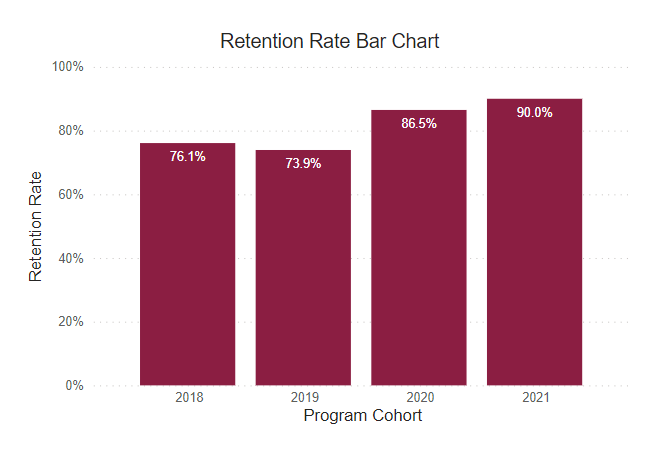
Retention Rate
This rate reflects the continuous term-to-term persistence rate for certificate programs and the fall-to-fall retention rate for associate degree programs.
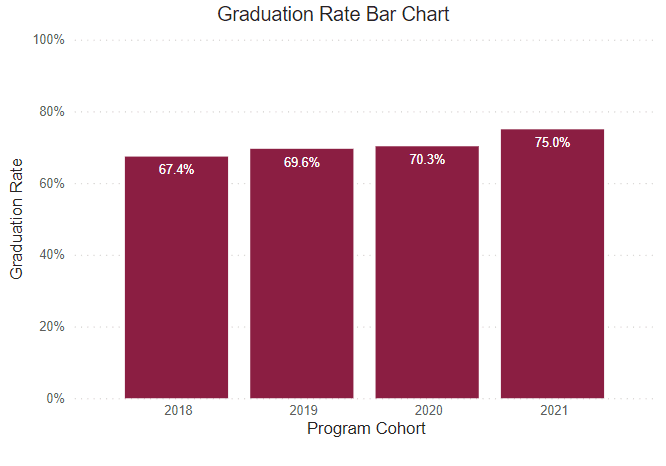
Graduation Rate
This rate reflects the number of freshmen who were officially enrolled in the fall semester and earned a certificate or degree within the expected timeframe.
Post Graduate Survey Response Rate
The post graduate survey is an annual on-line post graduate survey utilized by the college to gather vital information regarding career placement, starting salary, and level of satisfaction.
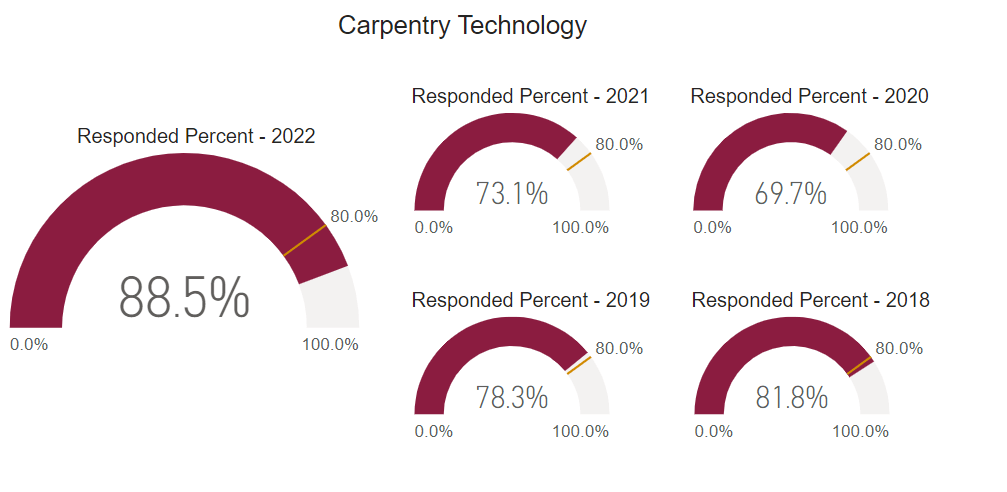
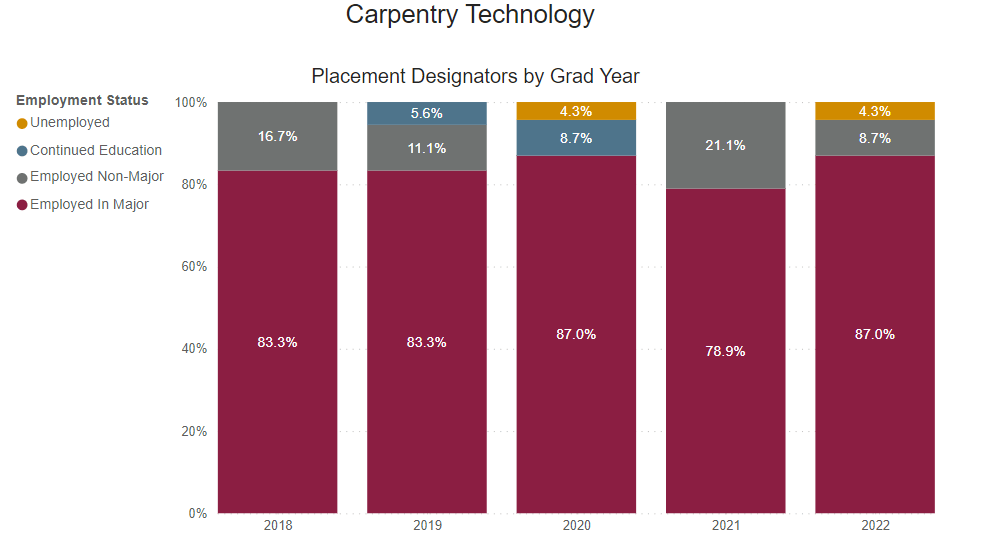
Employed Full Time Outside of Major
Percentage of graduates who reported being employed full-time outside their field of study.

Graduate Satisfaction
This is the median graduate survey response evaluating the level of preparation for workforce entry (based on a 5-Item Likert Scale).

Placement Rate
This is the percent of graduate survey respondents who reported being employed or continued their education on a full-time basis.

Employed Full Time Within Major
Percentage of graduates who reported being employed full-time within their field of study.
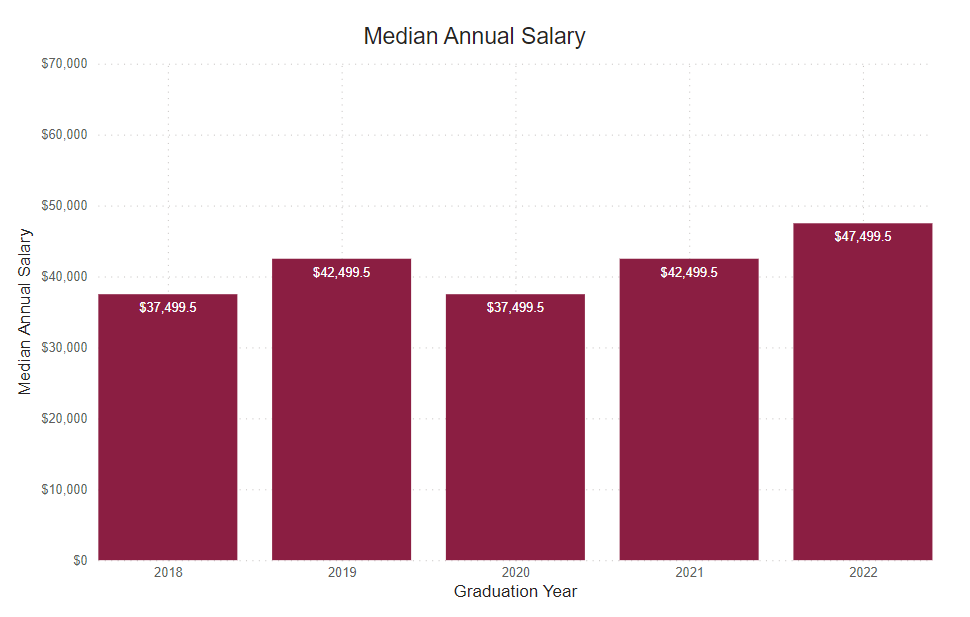
Annual Median Starting Salary
This number is based on the graduate survey response to the request to identify a starting salary from a range of options. This graph shows the median first-year annual salary. All calculations are based on the respondent’s self-reported first-year annual income.
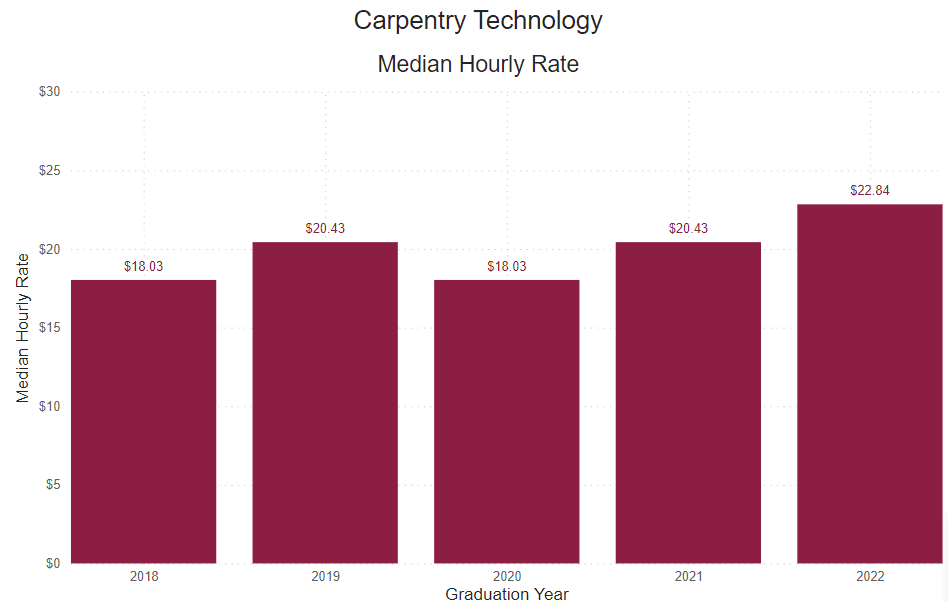
Reported Hourly Rate
This number is determined by dividing the reported median salary by the number of hours in a traditional full-time work week (40), then the number of weeks in a year (52).

Our graduates work with the industry’s best




